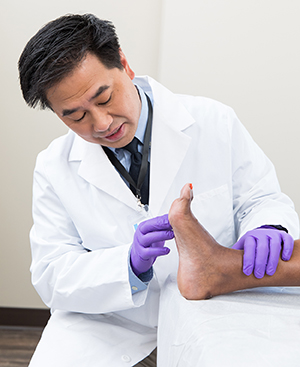Treating Pressure Injuries of the Foot
Hot spots, small cracks, and sores need to be treated by your health care provider before they get infected. If the spot is already infected, your provider will prescribe medicine. If the infection has spread, you may need surgery.
To avoid serious foot problems that could result in losing a toe, foot, or leg, follow these guidelines:
Inspect your feet daily. Check for cuts, blisters, redness, swelling or nail problems. Use a magnifying hand mirror to look at the bottom of your feet. Call your doctor if you notice anything.
Bathe feet in lukewarm, never hot, water. Use the water temperature you would use on a newborn baby. Keep your feet clean by washing them daily.
Be gentle when bathing your feet. Wash them using a soft washcloth or sponge. Dry by blotting or patting. Dry carefully between the toes.
Moisturize your feet but not between your toes. Use a moisturizer daily to keep dry skin from itching or cracking. But don't moisturize between the toes—that could encourage a fungal infection.
Cut nails carefully. Cut them straight across and file the edges. Don’t cut nails too short. This could lead to ingrown toenails. If you have concerns about your nails, consult your doctor.
Never treat corns or calluses yourself. No “bathroom surgery” or medicated pads. Visit your doctor for appropriate treatment.
Wear clean, dry socks. Change them daily.

Check your feet
What to look for:
-
Use a mirror to look at the bottom of your feet each day. This way, you can catch small skin changes before they turn into pressure injuries.
-
Call your health care provider if you notice hot spots, red streaks, swelling, or any cracks or sores. Don't try to treat corns or calluses yourself.
-
Check the soles and insides of your shoes before putting them on. Remove any objects, such as pebbles.
Do your best to control health problems that may affect your feet. Eat right and exercise. If you are given medicines, take them as directed. Always wear shoes or slippers, even in the house. If you smoke, get help to stop. Smoking reduces blood flow and slows healing. Limit how much alcohol you drink. You may need surgery to improve the blood supply to your feet.
Cleaning pressure injuries
To aid healing, your health care provider may clear away the thick skin around the pressure injury. They may put medicated ointment or cream on the injury to prevent infection. Sometimes dressing is used to help keep the wound dry.
Reducing force
To take pressure off hot spots and pressure injuries, your health care provider may prescribe custom-made shoe inserts. These absorb or move pressure from problem areas. You may need special shoes or temporary casts. You may also need surgery to correct claw toes or hammertoes. This can reduce pressure injuries.
Using antibiotics
To control or prevent infection, your health care provider may prescribe antibiotics. Take them as directed. If you stop using them too soon, the infection may come back.
If you need surgery
You may need surgery if infection enters deep tissues or bone. In such cases, your health care provider cleans away the infection. They remove as little tissue or bone as possible. You will likely be given antibiotics by an intravenous line (IV). This will be inserted into your hand or arm to fight the infection.